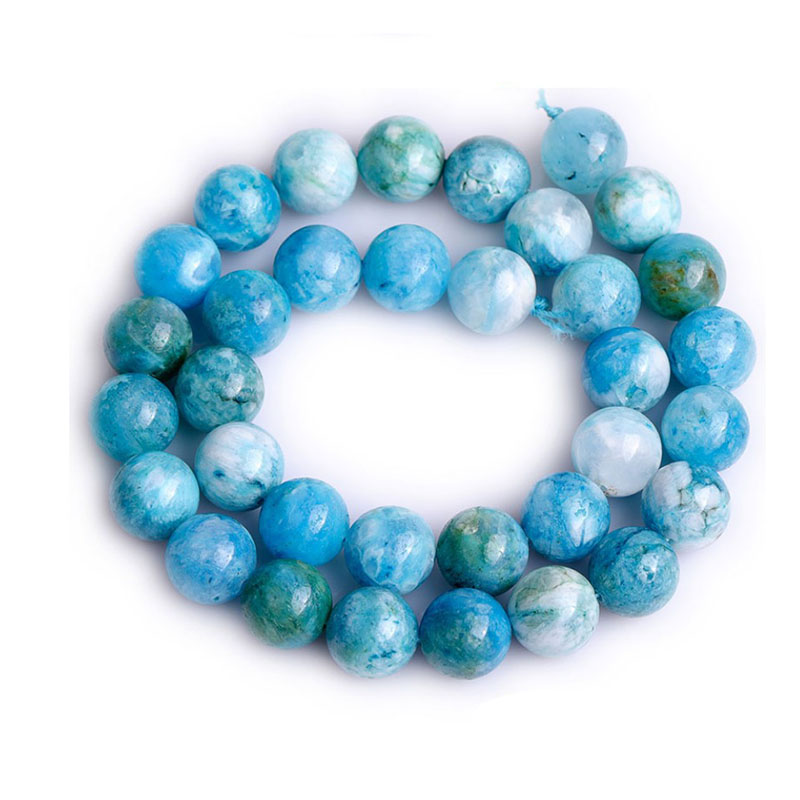Hemimorphite is a rare gemstone, mainly produced in the oxidation zone of lead-zinc deposits. They are secondary oxidation minerals, most of which occur as veins. It usually produces in limestone and coexists with sphalerite, smithsonite, galena, limonite, etc.
The refractive index of Hemimorphite is 1.612~1.630, and the birefringence is 0.018; The Mohs hardness is 4.5~5; The relative density is 3.45g/cm; It is characterized by shell-shaped, kidney-shaped and concentric radial structures; Transparent to translucent, glass luster.
The crystals of Hemimorphite are white, yellow, gray, brown, etc. Only when copper is contained, the color is blue, blue-green or green. Hemimorphite is a unique variety of jewelry and jade in China, called China Blue, which is extremely rare and has high collection and appreciation value. It is the favorite of the mineral collection industry.

Basic properties of Hemimorphite
Chemical composition
Hemimorphite is a zinc silicate mineral and one of the main zinc-bearing minerals. It is used to extract metal zinc in industry.
Its chemical formula is Zn₄(H₂O)[Si₂O₇](OH)₂. It often contains Pb, Fe and other elements.
Crystal system and crystal morphology
It belongs to the Orthorhombic crystal system. Single crystals are usually in the form of plates or cones parallel to {010}, and the upper and lower ends of the c-axis can be composed of different crystal planes.
Aggregates are often in the form of radiation, pompon, kidney or stalactite, and fine-grained aggregates or soil aggregates.
Other basic properties
1) Color: usually white or colorless, sometimes green, blue, yellow, brown, etc.
2) Gloss: glass luster. The surface of {001} sometimes shows pearl luster.
3) Transparency: Transparent to translucent.
4) Cleavage: with {110} complete cleavage and {101} incomplete cleavage.
5) Mohs hardness: 4.5~5.
6) Density: 3.4 ~ 3.5g/cm.
7) Optical property: inhomogeneous body, biaxial crystal, positive optical property.
8) Refractive index: Np=1.614, Nm=1.617, Ng=1.636.
9) Others: It has strong thermoelectricity.
Origin of Hemimorphite
Hemimorphite is generally a secondary mineral formed after the oxidation of sphalerite (ZnS) and coexists with smithsonite, galena, limonite, etc.
Hemimorphite and smithsonite are often mixed and produced together.
Hemimorphite is produced in many places, such as Mexico, the United States, Britain, Germany, Italy, Austria, etc. The gem grade Hemimorphite produced in Mexico has a crystal length of several centimeters and good transparency.
What is the difference between Hemimorphite and turquoise?
The colors of blue and blue-green Hemimorphite are very similar to turquoise, so they are easy to mistake as turquoise. The conventional data of Hemimorphite are close to that of turquoise, which is not easy to distinguish. We can determine Hemimorphite and turquoise from the following aspects.
1. Transparency
Hemimorphite is mainly transparent to translucent, which differs significantly from the transparency of turquoise
2. Structure
Amplification inspection shows that the Hemimorphite often presents radial and fibrous structure, which is not possessed by turquoise.
3. Large instrument testing
Infrared spectroscopy, Raman spectroscopy and trace element testing can effectively distinguish Hemimorphite from turquoise.
Hemimorphite feature
Hemimorphite is similar to smithsonite (the carbonate mineral of zinc). Still, the difference is that the latter frothed in cold dilute hydrochloric acid, while Hemimorphite is soluble in hydrochloric acid but does not froth.
2. Ornamental value
The perfect crystal shape, bright colors, and beautiful collection shape have high ornamental value.
Energy form
The crystal form of Hemimorphite is very unstable, with massive, spherical plate crystals. Like crystal, it has piezoelectricity. When energy is applied, electric charges will radiate from both ends.
Hemimorphite belongs to the orthorhombic crystal system and has more than two different forms, which shows that its energy is lively and can make people feel relaxed and energetic.
Hemimorphite can help people who need to change their life inertia, face their problems relaxed and joyfully, and no longer stay in the traditional moral framework.
How to use Hemimorphite
People can wear Hemimorphite to adjust their distance from others, maintain their unique color and establish healthy interpersonal relationships.
Hemimorphite can be used to help people suffering from physical pain. Placing Hemimorphite in the affected area can relieve discomfort.
For those who can’t get rid of the family influence and bear the family pressure, the use of Hemimorphite can also make them live up to their true colors.
When to use Hemimorphite
· When troubled by family influence
· When you can’t determine your real needs
· Be self-indulgent and help others
· Want to know your mission
· Relieve arthritis or physical problems
How to Clean Hemimorphite
Purification mode
√: Sound method and crystal cavity method
×: Sea salt, flowing water and sunlight will make the ore body discolored or fragile, and the fumigation law may make the mineral stain
Conclusion:
Hemimorphite is usually the product of Sphalerite oxidation, which is mainly formed in the oxidation zone of lead zinc sulfide deposits and is often associated with smithsonite, galena, limonite, calcite, aluminum sulfate and other minerals.
The crystals of Hemimorphite are thin, with longitudinal stripes on the surface, and also appear as massive, dense, grape-shaped, granular, fibrous, and shell-shaped aggregates;
The colors are various, including white, colorless, blue, gray and brown. The fracture is shell-shaped or uneven, and the streak is colorless, with glass luster or silk luster, from transparent to translucent.
Because of its vast energy and its ability to release stably and peacefully, it is often used in medical care. After people wear it as an accessory, they can feel calm.
Hemimorphite is similar to smithsonite, but the difference is that it will not bubble when encountering acid.
